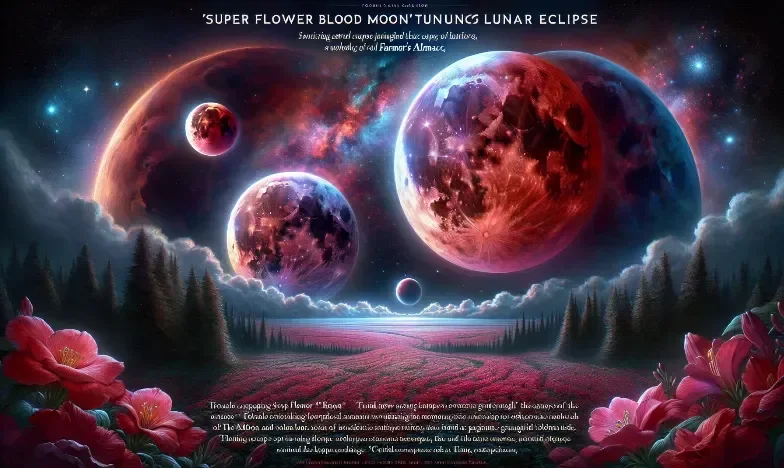Mesmerizing ‘Super Flower Blood Moon’ Lunar Eclipse to Grace the Skies This Week
This week, skywatchers across the United States are in for a treat as a rare and stunning celestial event is set to unfold. According to “The Old Farmer’s Almanac,” a ‘Super Flower Blood Moon’ lunar eclipse will grace the night skies on Tuesday, May 25, and Wednesday, May 26. This extraordinary phenomenon combines three unique lunar events into one spectacular show.
Roger, an avid stargazer from Arizona, has been eagerly anticipating this event for months. “I’ve always been fascinated by the night sky,” he says. “The ‘Super Flower Blood Moon’ is something I’ve never seen before, and I can’t wait to witness it.”
So, what exactly makes this lunar eclipse so special? Let’s break it down:
-
Supermoon: A supermoon occurs when the moon is at its closest point to Earth in its orbit, known as perigee. This makes the moon appear larger and brighter than usual. The term “supermoon” was coined by astrologer Richard Nolle in 1979 and has since become a popular way to describe this phenomenon.
-
Flower Moon: The full moon in May is traditionally called the “Flower Moon” because it coincides with the blooming of flowers in the Northern Hemisphere. This name has its roots in Native American culture and has been passed down through generations.
-
Blood Moon: During a total lunar eclipse, the Earth passes between the sun and the moon, casting a shadow on the moon’s surface. As the Earth’s atmosphere filters sunlight, it scatters shorter wavelengths of light (such as blue) and allows longer wavelengths (such as red) to pass through. This gives the moon a reddish hue, earning it the nickname “Blood Moon.”
Albert, a retired astronomer from California, explains the significance of this event. “The combination of a supermoon, flower moon, and blood moon is incredibly rare,” he says. “It’s a unique opportunity for people to witness the beauty and complexity of our universe.”
The best time to view the ‘Super Flower Blood Moon’ will be during the early morning hours of Wednesday, May 26. The total lunar eclipse will begin at approximately 4:11 AM PDT and reach its peak at 4:18 AM PDT. The entire eclipse will last for about 15 minutes, so be sure to set your alarms and find a good viewing spot.
Zachary, a high school science teacher from Texas, plans to use this event as a teaching opportunity for his students. “I’m encouraging my students to wake up early and watch the eclipse,” he says. “It’s a great way to spark their interest in astronomy and help them understand the science behind these phenomena.”
For those who may not be able to see the eclipse in person due to weather conditions or other factors, there are several live streams available online. Websites like NASA TV and Slooh will be broadcasting the event, allowing viewers from around the world to experience the magic of the ‘Super Flower Blood Moon.’
Quinn, an amateur photographer from New York, is preparing his camera equipment for the big night. “Capturing celestial events like this is one of my passions,” he says. “I’m hoping to get some amazing shots of the blood moon against the city skyline.”
As excitement builds for this rare lunar event, it’s important to remember that moments like these remind us of our place in the universe. Violet, a poet from Oregon, reflects on the significance of the ‘Super Flower Blood Moon.’ “There’s something deeply humbling about watching these cosmic events unfold,” she says. “It reminds us of the beauty and mystery that exists beyond our everyday lives.”
So, whether you’re an experienced astronomer or simply someone who enjoys gazing at the night sky, make sure to mark your calendars for this week’s ‘Super Flower Blood Moon’ lunar eclipse. It’s an event you won’t want to miss.
